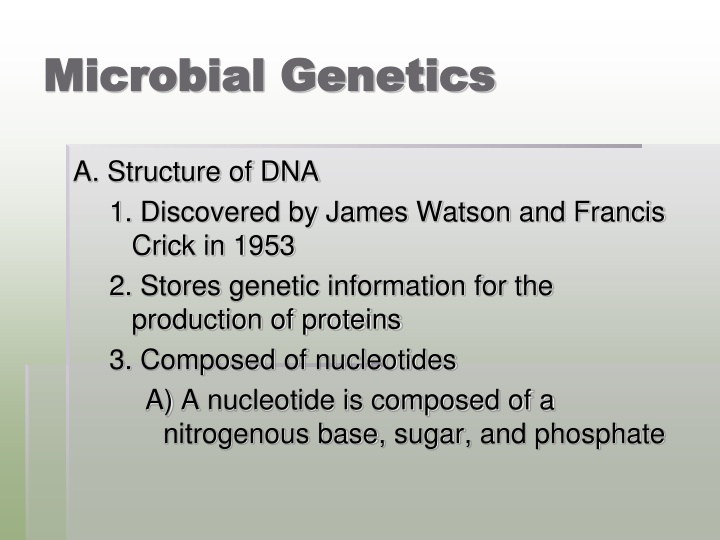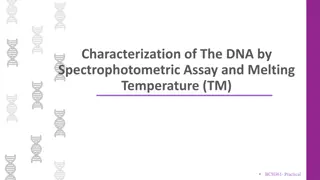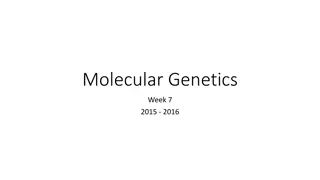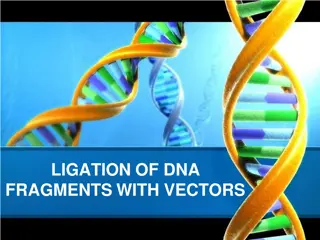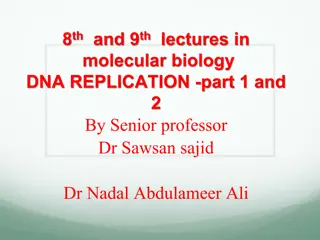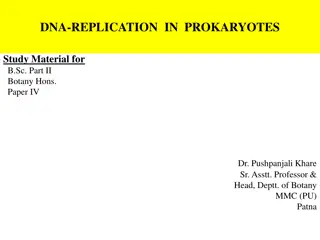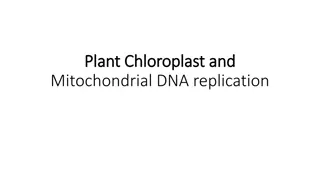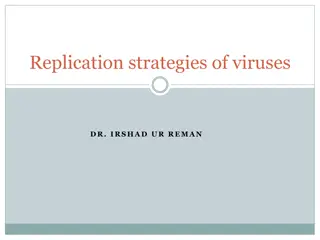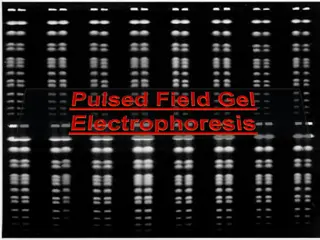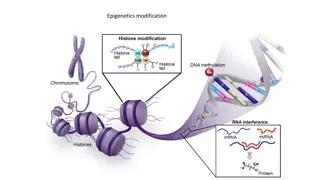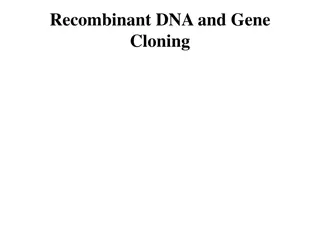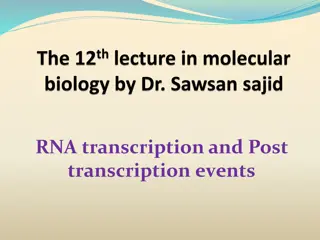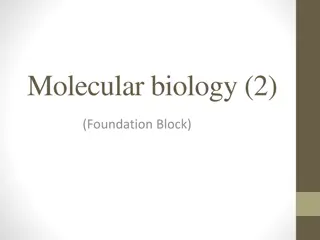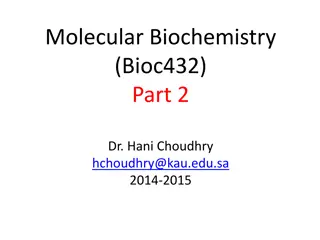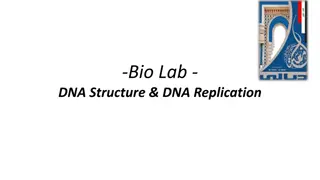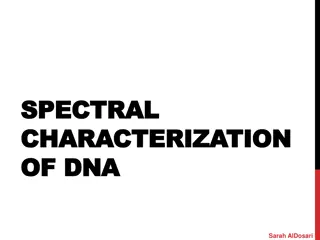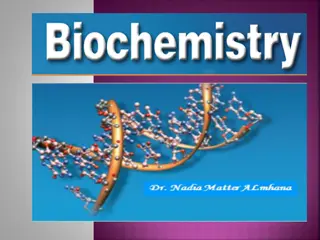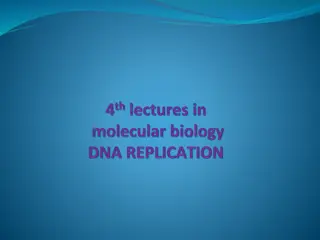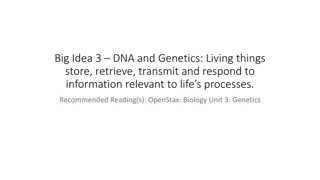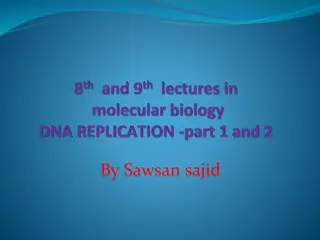DNA: Structure, Replication, and Expression
DNA, discovered by Watson and Crick, stores genetic information in nucleotides consisting of nitrogenous bases, sugar, and phosphate. It forms a double helix with adenine, guanine, thymine, and cytosine bases following specific pairing rules. DNA replication is semi-conservative using enzymes like helicase, DNA polymerase III, RNA primase, and ligase. Expression involves transcription and translation to produce proteins.
Download Presentation

Please find below an Image/Link to download the presentation.
The content on the website is provided AS IS for your information and personal use only. It may not be sold, licensed, or shared on other websites without obtaining consent from the author.If you encounter any issues during the download, it is possible that the publisher has removed the file from their server.
You are allowed to download the files provided on this website for personal or commercial use, subject to the condition that they are used lawfully. All files are the property of their respective owners.
The content on the website is provided AS IS for your information and personal use only. It may not be sold, licensed, or shared on other websites without obtaining consent from the author.
E N D
Presentation Transcript
Microbial Genetics Microbial Genetics A. Structure of DNA 1. Discovered by James Watson and Francis Crick in 1953 2. Stores genetic information for the production of proteins 3. Composed of nucleotides A) A nucleotide is composed of a nitrogenous base, sugar, and phosphate
Microbial Genetics Microbial Genetics 1) The 4 bases of DNA are adenine, guanine, thymine, and cytosine 2) Sugar deoxyribose 3) Phosphate PO4 B) Bases attach to 1 carbon C) Hydroxyl (-OH) group on the 3 carbon D) Phosphate group on 5 carbon
Microbial Genetics Microbial Genetics 4. Nucleotides arranged in chains (strands) A) The ends of each strand are identified by the number of the carbon nearest to that end 5. Bases are held together by H+bonds A) Base Pairing Rules 1) A with T 2) G with C 6. DNA is a complementary, antiparallel, double helix
Microbial Genetics Microbial Genetics B. DNA Replication 1. Semi-Conservative Replication A) Results in 2 molecules; each with 1 original strand and 1 new strand B) Uses multiple enzymes: 1) DNA helicase unwinds the double helix a) Breaks H+bonds between bases
Microbial Genetics Microbial Genetics 2) DNA Polymerase III builds new strands a) Cannot add nucleotides without one already being present (cannot start from scratch) i) Requires an RNA primer (a) Small section of RNA that initiates DNA replication (i) Created by RNA primase (can start from scratch)
Microbial Genetics Microbial Genetics b) Can only add new nucleotides to the 3 end of an already existing chain i) Therefore the enzyme must read the original in a 3 to 5 direction and the new DNA is built in a 5 to 3 direction 3) DNA Polymerase I removes & replaces the RNA primer(s) with DNA 4) DNA ligase joins together DNA fragments
Microbial Genetics Microbial Genetics C. DNA Expression 1. Transcription-Translation A) Process by which information is taken from DNA and used to make proteins 2. Transcription A) Process by which RNA is created from a DNA template
Microbial Genetics Microbial Genetics B) RNA polymerase reads the template DNA strand and creates a complementary RNA strand 1) It recognizes promoter and termination regions on the DNA template 3. Translation A) Process by which a polypeptide strand is created from a mRNA template B) Occurs in the ribosome
Microbial Genetics Microbial Genetics C) Ribosome begins reading the mRNA strand until it reaches the start codon (AUG) 1) Codon three-nucleotide sequence that represents one amino acid D) tRNA brings in the appropriate amino acid for the AUG codon E) The next codon is read and another amino acid comes in forming a peptide bond with the previous one
Microbial Genetics Microbial Genetics F) This continues until the ribosomes reaches a stop (nonsense) codon on the mRNA 1) Can be UAA, UAG, or UGA G) The new protein is released to the cell for use or release
Microbial Genetics Microbial Genetics Genetic Engineering A. Tools & Techniques 1. DNA strand properties A) Strands denature (separate) at near-boiling temperatures B) Strands renature (reform) as the strands cool
Microbial Genetics Microbial Genetics 2. Enzymes A) Restriction endonucleases 1) Capable of recognizing specific sequences and clipping the DNA at that location 2) Used to splice pieces of DNA into plasmids and chromosomes
Microbial Genetics Microbial Genetics B) DNA Ligase 1) Used to rejoin DNA fragments C) DNA & RNA polymerases 1) Used to make new strands of DNA or RNA (respectively)
Microbial Genetics Microbial Genetics D) Reverse transcriptase 1) Uses an RNA template to create a strand of DNA 2) Can be used to help sequence RNA or examine DNA with the junk segments removed
Microbial Genetics Microbial Genetics 3. Visualization A) Electrophoresis 1) Uses an electrical current and a gelatin-like medium to create a visual pattern of DNA fragments
Microbial Genetics Microbial Genetics 4. Oligonucleotides A) Smaller segments of DNA created for research purposes B) Most eukaryotic DNA is too large to study as a whole; oligonucleotides allow it to be studied in pieces and then information is consolidated to observe the whole genome
Microbial Genetics Microbial Genetics C) Oligonucleotides can also be sequenced using a sequencer 1) Can sequence 500-10 million bp segments at a rate of about 1000 bp/day
Microbial Genetics Microbial Genetics 5. Polymerase Chain Reaction (PCR) A) Allows one to create millions of copies of a specific segment of DNA B) Most often know in advance the segments to be copied C) Requires: 1) A sample of the original DNA with the segment to be copied
Microbial Genetics Microbial Genetics 2) The appropriate endonucleases to extract the desired segment 3) The appropriate RNA primer to initiate replication of that segment 4) DNA polymerase III to make copies of that segment 5) A thermal cycler to heat and cool the DNA so it can denature and renature multiple times
Microbial Genetics Microbial Genetics B. Recombinant DNA 1. Recombination A) The transfer of DNA from one organism to another 1) Results in a new genetic strain different from the donor and original recipient 2) Normally involves the transfer of plasmids
Microbial Genetics Microbial Genetics 3) The recipient organism must accept the DNA into its genetic make-up, express it, and pass it on to its offspring for the transfer to be successful 4) Can occur naturally or artificially
Microbial Genetics Microbial Genetics B) 3 mechanisms of natural transfer 1) Conjugation a) Involves a pilus b) Pilus forms a bridge between the 2 organisms and a replicated plasmid is transferred
Microbial Genetics Microbial Genetics c) Only certain bacteria are able to produce a pilus but that trait is also transferred through this process d) Generally limited to organisms of the same genus
Microbial Genetics Microbial Genetics 2) Transformation a) A cell picks up a piece of DNA from the environment usually from a lysed cell b) Allows a cell to get genetic material from an entirely different species
Microbial Genetics Microbial Genetics 3) Transduction a) Involves infection by bacteriophage b) The phage carries genetic material from its previous host cell into the new host
Microbial Genetics Microbial Genetics C) Genes can also be introduced artificially 1) Transfection process of artificially introducing genes into organisms
Microbial Genetics Microbial Genetics a) Transfected orgs. may be patented b) Can be microbes, plants, or animals i) Bacteria (a) Plays a major role in agriculture (i) Can act as insecticides
Microbial Genetics Microbial Genetics ii) Viruses (a) Often used to transmit the gene into another organism (i) Vector a microbe or virus that transmits material (wanted or unwanted) into a host organism (b) Gene therapy, experimental vaccines, and pathogenic testing all use transfected viruses
Microbial Genetics Microbial Genetics iii) Plants (a) Can introduce a number of new characteristics (i) Herbicide resistance (ii) Built-in insecticide (iii) Microbial resistance
Microbial Genetics Microbial Genetics iv) Animals (a) Serve many valuable purposes (i) Production of human hormones, antibodies, and enzymes (ii) The study of human disorders (iii) Healthier meat products (iv) Replacement tissues and organs (v) Nearly all early research involving human genetic therapy
